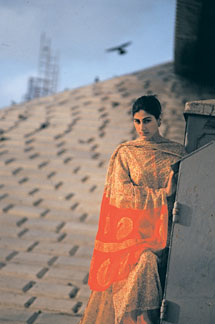
Things weren’t always this formatted. Back in the 1960s, women in Pakistan may have been more stylish but what they wore was seldom coming from an organised industry. Sughra Kazmi, Pakistan’s original bridal revivalist, was perhaps the first person who was acknowledged and acclaimed as a couturier.

Maheen Khan, back in the late ’60s, was known as The Seamstress in Lahore and operated her business from her veranda. It was only after years of training under French designers, investing in Stockman mannequins and acquiring pattern-making skills that she became ‘The Maheen Khan’ we know and admire today. Not many people know that She magazine, conceived and developed by a young Zuhra Karim to give a voice to Pakistan’s progressive women, was also one of her first jobs.
Maheen Khan’s rise to fame was slow and steady but sudden and monumental was the arrival of Pakistan’s biggest fashion brand ever — TeeJays. In the ’70s, when there was one state-run TV channel, almost no fashion magazines and absolutely no concept of PR, Tanvir Jamshed was the visionary who used PTV’s uber popular plays to promote awami fashion. Hasina Moin’s 1973 hit serial Kiran Kahani was TeeJays first commercial success and over the next decade or so there came more than two dozen more. This generation will be most familiar with the popularity of Marina Khan’s wardrobe from Tanhaiyyan, another brilliant serial by Moin. The colour-contrasted patchwork shalwar kameezes that Marina Khan was seen wearing became all the rage throughout the ’80s.

By the end of the ’80s, there was a burgeoning of names like Bunto Kazmi (who stepped into her mother-in-law’s shoes), Faiza Samee, Nilofer Shahid, Rizwan Beyg, Shamaeel, Sana Safinaz, Amir Adnan and the Body Focus Museum. The year 1989 witnessed Pakistan’s very first organised fashion show for Maheen Khan, with Frieha Altaf, her sister Neshmia and Atiya Khan as catwalk models. Karachi emerged as Pakistan’s fashion capital. This was the beginning of a new era.
Fashion flourished through the ’90s but it was in the early 2000s, when the first batch of young and enthusiastic fashion designers graduated from the Pakistan School of Fashion Design in Lahore, that the structure of fashion changed forever. Suddenly, there was a new guard that buzzed with business on their minds. It wouldn’t be wrong to say that HSY, Maheen Kardar, Nomi Ansari, Maria B and Kamiar Rokni amongst others were to change the way Pakistani fashion was seen and marketed forever.

In Karachi, designers like Sonya Battla emerged with a stronghold on design and business. Events like the Lux Style Awards and the Carnivale de Couture gave designers platforms to flaunt themselves on until fashion weeks rolled in 2008. And that was the beginning of a new age altogether.
What we see these days is the ultimate corporatisation of fashion. In a way it’s good because it urges designers to collaborate with industry-level players, as Maheen Karim and Sanam Chaudhri have with Bonanza, Adnan Pardesy with Working Women etc. Sana Safinaz and Sania Maskatiya are two names that have stepped into large-scale retail through flagship stores. All this means a better look for the high street at a lower cost.
















































